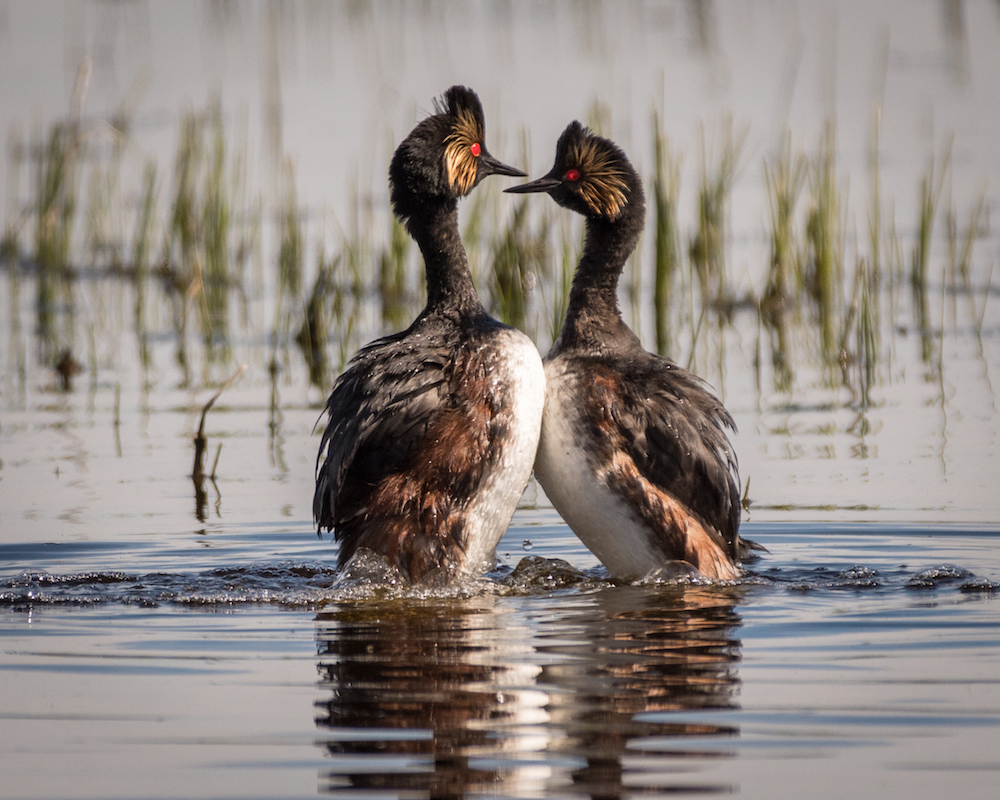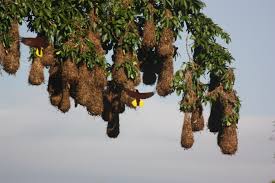
Most birds are monogamous but polygamy (polyandry = many males/one female, e.g. phalaropes and polygyny = many females/one male e.g. RW Blackbirds) are not uncommon. Promiscuous birds will mate with anybody of the opposite sex of the same species ( e.g. Brown-headed Cowbirds).
The birds may court and pair up during the winter (e.g. waterfowl) or find each other at the breeding grounds (most birds). The duration of the pair bond varies from one season to the next. Even as little as one copulation may be the extent of the pair bond; or the pair bond may last the life of an individual. If the same pair does nest year after year, it may be due more to the attractiveness of the territory or nest site rather than each other. Reliable evidence for true lifetime mating is scarce – it is hard to collect that kind of data. But there is some evidence for lifetime mating among eagles, wrentits, European nuthatches, the Brown Creeper, and lyrebirds.
Some pairs mate for several seasons while other pairs find new mates; this is true within one species as well as among species.
Pair bonds
1. Long term or life is only one type.
2. The sexes may remain together only for the breeding season, usually until the young have been raised ; most birds.
3. The sexes may remain together for weeks or months during courtship but separate when incubation begins: most ducks.
4. The sexes may remain together for only a few days or until incubation begins: RT Hummingbird, Philippine Weaverbird, Northern Phalarope.
5. Or the sexes may meet only for copulation: grouse, Prairie Chicken, Ruff.
Copulation
Although all birds have internal fertilization, most do not have a penis; a penis is only present in waterfowl and the large flightless birds. Copulation may continue regularly and only stop when egg laying is over or may continue through incubation. In some species, copulation is necessary to stimulate nest-building and/or incubation.
The entire process of courtship and reproduction is complex, with external stimuli and hormones interacting to produce a sequence of events from copulation to incubation. Most often the external stimulus is the lengthening period of daylight. A less passive influence is exemplified by the Red-billed Quelea of Africa which starts to breed when green grass emerges after a heavy rainfall.
Courtship Patterns
Are incredibly varied – from very simple to very complex. They involve sounds (calls, drumming, bill clapping, feather vibrating); visual signals (crests, plumes, tails, bright colors, air sacs); behavior (dances, hanging upside down, flight displays);nests and territories (bowers, leks) etc. More on avian mating systems.
Nesting
Most birds build a nest each time before breeding; a very few use the same nest for years. The nest site may be selected by the female (grouse, pheasants, wagtails); by the male (starling, House Sparrow); or by both sexes ( doves, Corvidae, titmice). The first time a bird builds a nest it takes longer than subsequent ones – they learn by practice. The first nest of the season takes longer to build than later nest – if they build a later nest. If a bird nests twice in a season (some do regularly and some do only if the first nest is destroyed) – the second nest takes less time to construct and is usually not as well done.
Nest Structure
King and Emperor Penguins hold their egg on top of their feet to incubate it; other penguins lay their eggs in burrows or caves or build simple nests out of rocks.Potoos lay a single egg on the top of a broken tree stub. The Oilbird builds a cone-shaped nest of seeds and droppings. Megapodes (brush turkeys) lay eggs in decomposing leaf pile and cover and uncover the eggs as needed to regulate the heat.Cave Swifts of China make their nests entirely out of saliva ( from which bird’s nest soup is made).Tailor birds sew together the edges of one or more leaves and lay eggs in the folds.Woodpeckers nest in cavities that they make themselves; others such as the Crested FC and Ash-throated FC, Starlings, and nuthatches use these cavities. Oropendola (see photo) and Weaverbirds build long hanging nests.The hornbill male walls the female into a tree cavity with a wall of mud, leaving only a small hole through which to feed her and the young.
Clutch Size
The number of eggs laid by different species of birds for a single nesting ranges from 1-25.
1 egg: most penguins, albatrosses, sunbirds, lyrebirds
2 eggs: some penguins, loons, boobies, gannets, doves
3 eggs: gulls, terns, grebes, blackbirds
2-9 eggs: temperate passerines
>9 eggs: chickens and relatives, waterfowl
Clutch size varies within a species due to a number of intrinsic and extrinsic factors.
1. Age of parent. For Kittiwakes, the average clutch size of females breeding for the first time is 1.8; for the second and third times is 1.9; for later times, 2.4.
2. Time of breeding – later clutches are generally smaller than those laid earlier in the season.
3. Food Supply. A positive correlation of food supply and clutch size has been documented for many predatory birds and a number of passerines.
4. Population Density – higher population densities are correlated with lower clutch size, probably due to reduced food supply. Demonstrated in Great Tits, Coal Tit, and Black Kites.
5. Latitude – clutch size in most species is positively correlated with latitude- the farther from the equator one gets, the larger the clutch size. The House Wren, for example, doubles its clutch size between Panama and North America. The Common Moorhen lays 3-4 eggs in the tropics and 5-10 in North America.
6. Habitat – tropical species have larger clutches in seasonal (temperate) habitats than in the tropics. They have more clutches (from 2 to 4) in the tropics.
7. Nest Site – protected nests (holes, domed nests) have larger clutches than open ones. In mid-European passerines, the average clutch size for open nesters is 5.1 and for protected nests 6.9.
8. Body Size – larger birds, with lower metabolism, live longer and thus have more opportunities to breed and these produce fewer young each time they breed.
The most common clutch size is the one that is most often successful – evolution limits maximum and minimum clutch sizes.
The largest known egg is that of the extinct Elephant Bird of Madagascar whose eggs held 7.5 liters and measured 34×24 cm. The smallest egg is that of the Vervain Hummingbird of Jamaica which is 10mm long; one Elephant Bird egg could hold 33,000 of these. Eggs of precocial species are larger than those of altricial species. In precocial birds, the yolk makes up 25-50 % of the egg weight, in altricial, 15%. Eggs: A Virtual Exhibition; More on Parenthood from PBS.
Does a bird need to copulate for each egg laid in a clutch or is one copulation sufficient for the whole clutch (or does this vary between species). The question is prompted by hybridized waterfowl, where only one duckling out of a clutch has the features and habits of another species. In this case one of 9 Gadwall (Anas strepera) ducklings looks and behaves like a Tufted duck (Aythya fuligula). The adult female and 8 chicks look and behave as expected, dabbling for food, whereas the 9th duckling has colouration of Tufted duck and dives for food.
Birds continue to copulate during egg laying more or less for keeping the pair bond together; an ejaculation of sperm can last up to three weeks in the female. But that has nothing to do with what you observed. Are you saying that a Gadwall mated with a Tufted Duck? I find that extremely unusual but if that is the case, then it is not unusual for one set of genes to dominate over the genes of the other sex.